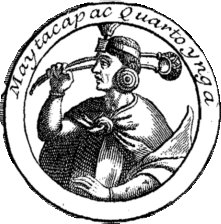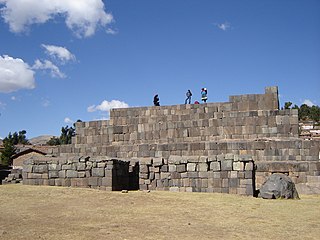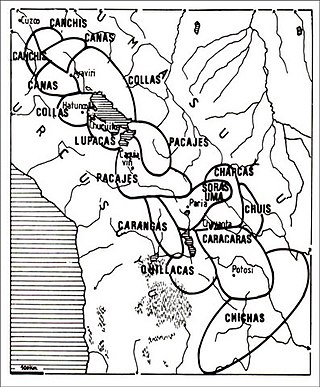
The Inca Empire, called Tawantinsuyu by its subjects, was the largest empire in pre-Columbian America. The administrative, political, and military center of the empire was in the city of Cusco. The Inca civilization rose from the Peruvian highlands sometime in the early 13th century. The Spanish began the conquest of the Inca Empire in 1532 and by 1572, the last Inca state was fully conquered.
Viracocha is the great creator deity in the pre-Inca and Inca mythology in the Andes region of South America. According to the myth Viracocha had human appearance and was generally considered as bearded. According to the myth he ordered the construction of Tiwanaku. It is also said that he was accompanied by men also referred to as Viracochas.

Manco Cápac, also known as Manco Inca and Ayar Manco, was, according to some historians, the first governor and founder of the Inca civilization in Cusco, possibly in the early 13th century. He is also a main figure of Inca mythology, being the protagonist of the two best known legends about the origin of the Inca, both of them connecting him to the foundation of Cusco. His main wife was his older sister, Mama Uqllu, also the mother of his son and successor Sinchi Ruq'a. Even though his figure is mentioned in several chronicles, his actual existence remains uncertain.

In Inca mythology, Mama Ocllo, or more precisely Mama Uqllu, was deified as a mother and fertility goddess. In one legend she was a daughter of Inti and Mama Killa, and in another the daughter of Viracocha (Wiraqucha) and Mama Qucha. In all of them she was the older sister and wife of Manco Cápac, whom she established the city of Cusco with. In some variations, she also had a son with him, Sinchi Roca, though all Incan rulers after Manco Cápac were believed to be their descendants.

Pachacuti Inca Yupanqui, also called Pachacútec, was the ninth Sapa Inca of the Kingdom of Cusco which he transformed into the Inca Empire. Most archaeologists now believe that the famous Inca site of Machu Picchu was built as an estate for Pachacuti.

The Inca road system was the most extensive and advanced transportation system in pre-Columbian South America. It was about 40,000 kilometres (25,000 mi) long. The construction of the roads required a large expenditure of time and effort.

The Sapa Inca was the monarch of the Inca Empire (Tawantinsuyu), as well as ruler of the earlier Kingdom of Cusco and the later Neo-Inca State. While the origins of the position are mythical and originate from the legendary foundation of the city of Cusco, it seems to have come into being historically around 1100 AD. Although the Inca believed the Sapa to be the son of Inti and often referred to him as Intip Churin or 'Son of the Sun,' the position eventually became hereditary, with son succeeding father. The principal wife of the Inca was known as the Coya or Qoya. The Sapa Inca was at the top of the social hierarchy, and played a dominant role in the political and spiritual realm.

A chasqui was a messenger of the Inca empire. Agile, highly trained and physically fit, they were in charge of carrying messages –in the form of quipus or oral information– and small packets. Along the Inca road system there were relay stations called chaskiwasi, placed at about 2.5 kilometres (1.6 mi) from each other, where the chasqui switched, exchanging their message(s) with the fresh messenger. The chasqui system could be able to deliver a message or a gift along a distance of up to 300 kilometres (190 mi) per day.

Mayta Cápac was the fourth Sapa Inca of the Kingdom of Cuzco and a member of the Hurin dynasty.

Cápac Yupanqui was the fifth Sapa Inca of the Kingdom of Cusco and the last of the Hurin dynasty.

Inca architecture is the most significant pre-Columbian architecture in South America. The Incas inherited an architectural legacy from Tiwanaku, founded in the 2nd century B.C.E. in present-day Bolivia. A core characteristic of the architectural style was to use the topography and existing materials of the land as part of the design. The capital of the Inca empire, Cuzco, still contains many fine examples of Inca architecture, although many walls of Inca masonry have been incorporated into Spanish Colonial structures. The famous royal estate of Machu Picchu is a surviving example of Inca architecture. Other significant sites include Sacsayhuamán and Ollantaytambo. The Incas also developed an extensive road system spanning most of the western length of the continent and placed their distinctive architecture along the way, thereby visually asserting their imperial rule along the frontier.

The Inca Bridge or Inka Bridge refers to one of two places related to access to Machu Picchu, in Peru.

Coricancha, Curicancha, Koricancha, Qoricancha or Qorikancha was the most important temple in the Inca Empire, and was described by early Spanish colonialists. It is located in Cusco, Peru, which was the capital of the empire.

In the Inca Empire the ushnu was an altar for cults to the deities, a throne for the Sapa Inca (emperor), an elevated place for judgment and a reviewing stand of military command. In several cases the ushnu may have been used as a solar observatory. Ushnus mark the center of plazas of the Inca administrative centers all along the highland path of the Inca road system.

Inca mythology is the universe of legends and collective memory of the Inca civilization, which took place in the current territories of Colombia, Ecuador, Peru, Bolivia, Chile, and Argentina, incorporating in the first instance, systematically, the territories of the central highlands of Peru to the north.
Ayar Cachi or Ayar Kachi was one of the brothers of Manco Cápac, who emerged from the cave at Paqariq Tampu. He could shoot down hills with a single shot of his sling.
Rodrigo Sutiq Callapiña was a native Inca who successfully claimed his nobility in colonial Spanish America in 1569.

Warawtampu is an archaeological site in the Pasco Region in Peru. It is located in Daniel Alcides Carrión Province, Yanahuanca District, in the community of the same name. The archaeological site of Astupampa is close to it.

The Colla, Qolla or Qulla Kingdom was established in the northwestern basin of the Titicaca, one of the Aymara kingdoms that occupied part of the Collao plateau after the fall of Tiwanaku. In the mid-15th century the Collas possessed a vast territory, one of the largest of the Aymara kingdoms, which at the time the 9th Sapan Inka Pachakutiq Yupanqui Qhapaq the Intipchurin, conquered along with other political entities in the region.
Mama Oqllu is a central figure in Inca creation myth. She is identified as one of the original founders of the Inca people and is credited with helping discover and settle the Inca capital of Cuzco in highland Peru.
G. Urton, The History of a Myth: Pacariqtambo and the Origin of the Inkas (Univ. of Texas Press, 1990)















